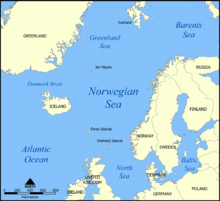Denmark Strait (original) (raw)
From Wikipedia, the free encyclopedia
Strait between Greenland and Iceland
Map showing the Denmark Strait
Pack ice in the Denmark Strait
The Denmark Strait[a] is the strait that separates Greenland from Iceland. The Norwegian island of Jan Mayen lies northeast of the strait.
The strait connects the Greenland Sea, an extension of the Arctic Ocean, to the Irminger Sea, a part of the Atlantic Ocean. It is 480 kilometres (300 mi) long. The narrowest part of the strait is 290 kilometres (180 mi) wide and lies between Straumnes, on Iceland's Hornstrandir peninsula, and Cape Tupinier, on Greenland's Blosseville Coast. According to the International Hydrographic Organization, the dividing line between the Arctic and the North Atlantic Oceans runs from Straumnes to Cape Nansen, 132 km (82 miles) southwest of Cape Tunipier.
The narrow depth, where the Greenland–Iceland Rise runs along the bottom of the sea, is 191 metres (625 ft). The cold East Greenland Current passes through the strait and carries icebergs south into the North Atlantic. It hosts important fisheries.
The world's largest known underwater waterfall, known as the Denmark Strait cataract, flows down the western side of the Denmark Strait.[1]
Battle of the Denmark Strait
[edit]
During World War II, the Battle of the Denmark Strait took place on 24 May 1941. The German battleship Bismarck sank the British battlecruiser HMS Hood, which exploded with the loss of all but three of her 1,418 crew; the battleship HMS Prince of Wales was seriously damaged in the engagement. Bismarck was able to enter the Atlantic through the Strait, but damage sustained in the battle—combined with British aircraft search-and-destroy missions—led to her own sinking three days later.
^ Known in Danish as the Danmarksstrædet ("Denmark Strait") and in Icelandic as the Grænlandssund ("Greenland Sound").
 Media related to Denmark Strait at Wikimedia Commons
Media related to Denmark Strait at Wikimedia Commons

